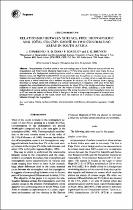 ResearchSpace
ResearchSpace
Relationship between surface, free tropospheric and total column ozone in 2 contrasting areas in South-Africa
JavaScript is disabled for your browser. Some features of this site may not work without it.
- ResearchSpace
- →
- Research Publications/Outputs
- →
- Journal Articles
- →
- View Item
| dc.contributor.author |
Combrink, J

|
en_US |
| dc.contributor.author |
Diab, RD

|
en_US |
| dc.contributor.author |
Sokolic, F

|
en_US |
| dc.contributor.author |
Brunke, EG

|
en_US |
| dc.date.accessioned | 2007-01-12T08:05:06Z | en_US |
| dc.date.accessioned | 2007-06-07T10:09:03Z | |
| dc.date.available | 2007-01-12T08:05:06Z | en_US |
| dc.date.available | 2007-06-07T10:09:03Z | |
| dc.date.issued | 1995-04 | en_US |
| dc.identifier.citation | Combrink, J, et al. 1995. Relationship between surface, free tropospheric and total column ozone in 2 contrasting areas in South-Africa. Atmospheric Environment, vol 29(6), pp 685-691 | en_US |
| dc.identifier.issn | 1352-2310 | en_US |
| dc.identifier.uri | http://hdl.handle.net/10204/1389 | en_US |
| dc.identifier.uri | http://hdl.handle.net/10204/1389 | |
| dc.description.abstract | Measurements of surface ozone in two contrasting areas of South Africa are compared with free tropospheric and Total Ozone Mapping Spectrometer (TOMS) total column ozone data. Cape Point is representative of a background monitoring station which is remote from pollution impacts, whereas the Eastern Transvaal Highveld (ETH) stations of Elandsfontein and Verkykkop are situated in an area of intense urban and industrial activity. At Cape Point the diurnal cycle in surface ozone is small; the seasonal cycle shows a winter maximum and a summer minimum. In contrast, the ETH stations show a spring maximum in surface ozone with evidence of a summer enhancement. Comparison with Cape Point data suggests that photochemical ozone production accounts for about 50% of the background value. Seasonal variations in total ozone are consistent over the whole of South Africa, indicating a cycle which is independent of varying surface ozone concentrations. The spring maximum in free tropospheric ozone (up to 12 km) over the interior of South Africa is thought to be due to long-range transport of biomass burn products from latitudes to the north, rather than the extension of a localised surface photochemical influence through the troposphere. | en_US |
| dc.format.extent | 713294 bytes | en_US |
| dc.format.mimetype | application/pdf | en_US |
| dc.language.iso | en | en_US |
| dc.publisher | Pergamon-Elsevier Science Ltd | en_US |
| dc.rights | Copyright: Pergamon-Elsevier Science Ltd | en_US |
| dc.subject | Surface ozone | en_US |
| dc.subject | Total ozone | en_US |
| dc.subject | Free tropospheric ozone | en_US |
| dc.subject | Stratospheric ozone | en_US |
| dc.subject | Environmental sciences | en_US |
| dc.subject | TOMS | en_US |
| dc.subject | Atmospheric environment | en_US |
| dc.subject | Atmospheric science | en |
| dc.title | Relationship between surface, free tropospheric and total column ozone in 2 contrasting areas in South-Africa | en_US |
| dc.type | Article | en_US |
| dc.identifier.apacitation | Combrink, J., Diab, R., Sokolic, F., & Brunke, E. (1995). Relationship between surface, free tropospheric and total column ozone in 2 contrasting areas in South-Africa. http://hdl.handle.net/10204/1389 | en_ZA |
| dc.identifier.chicagocitation | Combrink, J, RD Diab, F Sokolic, and EG Brunke "Relationship between surface, free tropospheric and total column ozone in 2 contrasting areas in South-Africa." (1995) http://hdl.handle.net/10204/1389 | en_ZA |
| dc.identifier.vancouvercitation | Combrink J, Diab R, Sokolic F, Brunke E. Relationship between surface, free tropospheric and total column ozone in 2 contrasting areas in South-Africa. 1995; http://hdl.handle.net/10204/1389. | en_ZA |
| dc.identifier.ris | TY - Article AU - Combrink, J AU - Diab, RD AU - Sokolic, F AU - Brunke, EG AB - Measurements of surface ozone in two contrasting areas of South Africa are compared with free tropospheric and Total Ozone Mapping Spectrometer (TOMS) total column ozone data. Cape Point is representative of a background monitoring station which is remote from pollution impacts, whereas the Eastern Transvaal Highveld (ETH) stations of Elandsfontein and Verkykkop are situated in an area of intense urban and industrial activity. At Cape Point the diurnal cycle in surface ozone is small; the seasonal cycle shows a winter maximum and a summer minimum. In contrast, the ETH stations show a spring maximum in surface ozone with evidence of a summer enhancement. Comparison with Cape Point data suggests that photochemical ozone production accounts for about 50% of the background value. Seasonal variations in total ozone are consistent over the whole of South Africa, indicating a cycle which is independent of varying surface ozone concentrations. The spring maximum in free tropospheric ozone (up to 12 km) over the interior of South Africa is thought to be due to long-range transport of biomass burn products from latitudes to the north, rather than the extension of a localised surface photochemical influence through the troposphere. DA - 1995-04 DB - ResearchSpace DP - CSIR KW - Surface ozone KW - Total ozone KW - Free tropospheric ozone KW - Stratospheric ozone KW - Environmental sciences KW - TOMS KW - Atmospheric environment KW - Atmospheric science LK - https://researchspace.csir.co.za PY - 1995 SM - 1352-2310 T1 - Relationship between surface, free tropospheric and total column ozone in 2 contrasting areas in South-Africa TI - Relationship between surface, free tropospheric and total column ozone in 2 contrasting areas in South-Africa UR - http://hdl.handle.net/10204/1389 ER - | en_ZA |





